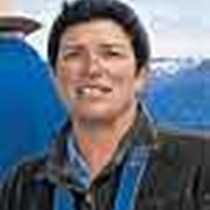Half Moon Caye Natural Monument
This morning we awoke surrounded by the turquoise waters of Half Moon Caye Natural Monument. The Caye is slender and long and is comprised of 45 acres of sand, palms and a dense ziricote forest. Surrounding the Caye is coral reef, rich in marine life.
After a brief Zodiac ride to the beach we settled into our surroundings and made our way to an observation platform set up by the Belize Audubon Society. The tower allowed us eye to eye encounters with nesting red-footed boobies and magnificent frigate birds. At the beginning of February local biologists did a census of the birds and found over 3900 red-footed boobies and approximately 3000 magnificent frigate birds utilizing the island. Many of the red-footed boobies already had large downy chicks at their sides, while the magnificent frigate birds were still busy working the Caribbean singles scene.
Along the trails cutting across the island we followed hermit crabs on the move. Ctenosaurs, or as locals call them, “wish-willies” crawled out on palm trunks in search of warm patches of sunlight. The local population of mamey fruit and hermit crabs provide a great food source for these lizard omnivores. Small anoles also made an appearance as the day heated up.
After a tasty barbecue lunch on the upper deck of the ship, we headed back to the caye for snorkeling and lounging on the north end of the island. Just off the beach, folks who ventured in to snorkel were greeted by corals and colorful local residents (see photo above). A few of us just opted to sit under the palms and enjoy the sun and cool ocean breeze. Cries of osprey and grackles serenaded us through the afternoon. A great end to our travels in the Mayan world.
This morning we awoke surrounded by the turquoise waters of Half Moon Caye Natural Monument. The Caye is slender and long and is comprised of 45 acres of sand, palms and a dense ziricote forest. Surrounding the Caye is coral reef, rich in marine life.
After a brief Zodiac ride to the beach we settled into our surroundings and made our way to an observation platform set up by the Belize Audubon Society. The tower allowed us eye to eye encounters with nesting red-footed boobies and magnificent frigate birds. At the beginning of February local biologists did a census of the birds and found over 3900 red-footed boobies and approximately 3000 magnificent frigate birds utilizing the island. Many of the red-footed boobies already had large downy chicks at their sides, while the magnificent frigate birds were still busy working the Caribbean singles scene.
Along the trails cutting across the island we followed hermit crabs on the move. Ctenosaurs, or as locals call them, “wish-willies” crawled out on palm trunks in search of warm patches of sunlight. The local population of mamey fruit and hermit crabs provide a great food source for these lizard omnivores. Small anoles also made an appearance as the day heated up.
After a tasty barbecue lunch on the upper deck of the ship, we headed back to the caye for snorkeling and lounging on the north end of the island. Just off the beach, folks who ventured in to snorkel were greeted by corals and colorful local residents (see photo above). A few of us just opted to sit under the palms and enjoy the sun and cool ocean breeze. Cries of osprey and grackles serenaded us through the afternoon. A great end to our travels in the Mayan world.




